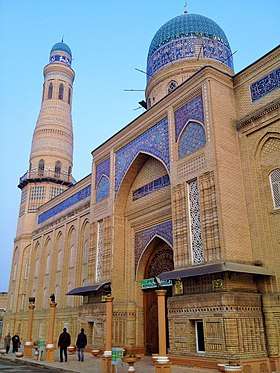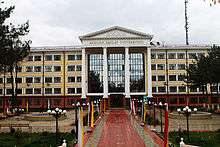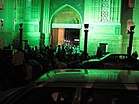Andijan
Andijan (sometimes spelled Andijon or Andizhan in English) (Uzbek: Andijon / Андижон / ئەندىجان; Persian: اندیجان, Andijân/Andīǰān; Russian: Андижан, Andižan) is a city in Uzbekistan. It is the administrative, economic, and cultural center of Andijan Region. Andijan is located in the south-eastern edge of the Fergana Valley near Uzbekistan's border with Kyrgyzstan.
Andijan Andijon/Андижон | |
|---|---|
City | |
 _-_Where_2005_Massacre_Took_Place_-_Andijon_-_Uzbekistan_(7544000842).jpg)   _-_Where_2005_Massacre_Took_Place_-_Andijon_-_Uzbekistan_-_01_(7543269364).jpg) | |
 Andijan Location in Uzbekistan | |
| Coordinates: 40°47′N 72°20′E | |
| Country | |
| Region | Andijan Region |
| First mention | 10th century |
| Area | |
| • Total | 74.3 km2 (28.7 sq mi) |
| Elevation | 500 m (1,600 ft) |
| Population (2014) | |
| • Total | 403,900 |
| • Density | 5,400/km2 (14,000/sq mi) |
| Time zone | UTC+5 (UZT) |
| • Summer (DST) | UTC+5 (not observed) |
| Postal code | 170100[1] |
| Area code(s) | +998 74[1] |
| Website | www |
Andijan is one of the oldest cities in the Fergana Valley. In some parts of the city, archeologists have found items dating back to the 7th and 8th centuries. Historically, Andijan was an important city on the Silk Road. The city is perhaps best known as the birthplace of Babur who, following a series of setbacks, finally succeeded in laying the basis for the Mughal dynasty in the Indian subcontinent and became the first Mughal emperor. Andijan also gained notoriety in 2005 when government forces opened fire on protestors, killing hundreds in what came to be known as the Andijan Massacre.
Andijan was developed into an important industrial city during the Soviet era. Manufactured goods produced in the city include chemicals, domestic appliances, electronics, foodstuffs, furniture, plows, pumps, shoes, spare parts for farming machines, various engineering tools, and wheelchairs.
History
Toponymy
The origin of the name of the city is uncertain. Arab geographers of the 10th century referred to Andijan as "Andukan," "Andugan," or "Andigan."[2] The traditional explanation links the name of the city to the Turkic tribal names Andi and Adoq/Azoq.[3]
Early and recent history
Andijan is one of the oldest cities in the Fergana Valley. Marhamat city of Andijan The ruins of Ershi, the capital of the Davan (Parkana) state, with more than 70 cities with a rich and dense population of the V - IV and IV centuries BC. In some parts of the city, archeologists have found items dating back to the 7th and 8th centuries.[3] Historically, Andijan was an important city on the Silk Road.[4]
The city is perhaps best known as the birthplace of Babur who, following a series of setbacks, finally succeeded in laying the basis for the Mughal dynasty in the Indian Subcontinent and became the first Mughal emperor.[5]
After the formation of the Khanate of Kokand in the 18th century, the capital was moved from Andijan to Kokand. In the mid-19th century, the Russian Empire began occupying the area of present-day Central Asia. In 1876, the Russians conquered the Khanate of Kokand and the city of Andijan along with it.
Andijan was the center and flashpoint of the Andijan Uprising of 1898 in which the followers of Sufi leader Madali Ishan attacked the Russian barracks in the city, killing 22 and injuring 16-20 more. In retaliation, 18 of the participants were hanged and 360 exiled.[6]
On 16 December 1902, much of the city was leveled by a severe earthquake which destroyed up to 30,000 homes in the region and killed as many as 4,500 residents.[4][7] After Soviet rule was established in Andijan in 1917, the city quickly became an important industrial city in the Uzbek SSR.
Modern history
During the Soviet demarcation of Central Asia, Andijan was separated from its historical hinterland as the Ferghana Valley was divided among three separate Soviet republics. Andijan itself became part of the Uzbek SSR.
During World War II, many Soviet citizens were evacuated to Andijan and the surrounding towns. Of the Jewish refugees fleeing Nazi-occupied Poland and banished by the Soviets to Siberia and Central Asia, some relocated to Andijan starting in 1941.
In the 1990s, Andijan and the surrounding region became politically unstable. Poverty and an upsurge in Islamic fundamentalism produced tensions in the region. The town, and the region as a whole, suffered a severe economic decline following the fall of the Soviet Union in 1991. Repeated border closures badly damaged the local economy, worsening the already widespread poverty of Andijan's inhabitants.
May 2005 massacre
On 13 May 2005, Uzbekistan's military opened fire on a mass of people who were protesting against poor living conditions and corrupt government.[8][9][10] The estimates of those killed on 13 May range from 187, the official count of the government, to several hundred.[8][11] A defector from the SNB alleged that 1,500 were killed.[12] The bodies of many of those who died were allegedly hidden in mass graves following the massacre.[13]
The Uzbek government at first stated that the Islamic Movement of Uzbekistan organized the unrest and that the protesters were members of Hizb ut-Tahrir.[14] Critics have argued that the radical Islamist label has been just a pretext for maintaining a repressive regime in the country.
Whether troops fired indiscriminately to prevent a colour revolution or acted legitimately to quell a prison break is also disputed.[15][16][17][18] Another theory is that the dispute was really an inter-clan struggle for state power.[10] The Uzbek government eventually acknowledged that poor economic conditions in the region and popular resentment played a role in the uprising.[19]
Geography
Andijan is located 450 metres (1,480 ft) above sea level in the south-eastern edge of the Fergana Valley near Uzbekistan's border with Kyrgyzstan.[3] By road it is 22 kilometres (14 mi) northeast of Asaka and 68.6 kilometres (42.6 mi) southeast of Namangan.[20] Andijonsoy flows along the city.
Food: Andijan is also known with fascinating dishes, one of the most popular food is Plov also known (Osh) in the local language. Nevertheless, there are some other delicious foods as well such as Somsa, Monti and Dolma in the local language. However, Andijan is also known for its dance called Andijan polka and it has been reported that this dance history goes all the way back to the old centuries.
Climate
Andijan has a cold semi-arid climate (Köppen climate classification BSk) with cold winters and hot summers, rendering a very continental nature, although winters are milder than one might expect for a location in Central Asia. Rainfall is generally light and erratic. Summers are particularly dry.
| Climate data for Andijan (1981–2010) | |||||||||||||
|---|---|---|---|---|---|---|---|---|---|---|---|---|---|
| Month | Jan | Feb | Mar | Apr | May | Jun | Jul | Aug | Sep | Oct | Nov | Dec | Year |
| Average high °C (°F) | 3.9 (39.0) |
7.5 (45.5) |
15.1 (59.2) |
22.8 (73.0) |
28.1 (82.6) |
33.4 (92.1) |
34.7 (94.5) |
33.0 (91.4) |
28.6 (83.5) |
21.3 (70.3) |
13.2 (55.8) |
5.4 (41.7) |
20.6 (69.1) |
| Average low °C (°F) | −3.6 (25.5) |
−1.4 (29.5) |
4.4 (39.9) |
10.3 (50.5) |
14.9 (58.8) |
18.9 (66.0) |
20.4 (68.7) |
18.6 (65.5) |
13.6 (56.5) |
7.4 (45.3) |
2.4 (36.3) |
−2.0 (28.4) |
8.7 (47.6) |
| Average precipitation mm (inches) | 22.9 (0.90) |
30.6 (1.20) |
34.1 (1.34) |
26.5 (1.04) |
24.7 (0.97) |
11.8 (0.46) |
4.9 (0.19) |
3.0 (0.12) |
4.0 (0.16) |
22.0 (0.87) |
28.2 (1.11) |
34.2 (1.35) |
246.9 (9.71) |
| Average precipitation days | 8 | 10 | 10 | 9 | 10 | 7 | 5 | 3 | 3 | 5 | 7 | 8 | 85 |
| Average relative humidity (%) | 84 | 81 | 72 | 62 | 54 | 46 | 50 | 57 | 60 | 68 | 77 | 86 | 66 |
| Mean monthly sunshine hours | 87.7 | 100.6 | 151.7 | 206.3 | 277.2 | 334.3 | 357.7 | 339.3 | 289.7 | 216.6 | 139.6 | 77.4 | 2,578.1 |
| Source 1: Centre of Hydrometeorological Service of Uzbekistan[21] | |||||||||||||
| Source 2: NOAA (sun and humidity 1961-1990)[22] | |||||||||||||
Demographics
In 2000, Andijan had a population of 333,400.[3] Representatives of many ethnic groups can be found in the city. Uzbeks are the largest ethnic group, followed by Tajiks.
| Year | Pop. | ±% |
|---|---|---|
| 1897 | 57,000 | — |
| 1939 | 105,000 | +84.2% |
| 1959 | 161,000 | +53.3% |
| 1970 | 188,000 | +16.8% |
| 1985 | 275,000 | +46.3% |
| 2000 | 333,400 | +21.2% |
| Source: [3][4][23] | ||
Economy
Andijan has been an important craft and trade center in the Fergana Valley since the 15th century. After annexation by the Russians in 1876, the economy of the city started to grow significantly. Several industrial plants were built in Andijan after the city was connected with Russia with a railway line in 1889.[23] Several hospitals, pharmacies, banks, and printing houses were established in the city during that period. After Soviet rule was established in late December 1917, both light and heavy industries developed significantly. Andijan became the first city in Uzbekistan to be fully supplied with natural gas.[23]
Andijan remains an important industrial city in independent Uzbekistan. There are 48 large industrial plants and about 3,000 small and medium enterprises in the city.[3] Manufactured goods produced in the city include chemicals, domestic appliances, electronics, foodstuffs, furniture, plows, pumps, shoes, spare parts for farming machines, various engineering tools, and wheelchairs. Andijan is also home to over 50 international companies, five of which produce spare parts for GM Uzbekistan.
Education
There are four higher education institutions in Andijan City. Andijan state university, Andijan medical institute, Andijan machine-building institute and Andijan branch Tashkent state agrarian university. The Andijan Medical Institute is the largest of the four. The city is also home to four colleges, one academic lyceum, 21 vocational schools, 47 secondary schools, three music and art schools, nine sports schools, and 86 kindergartens.[23]
Notable people
- Babur (1483–1530) — an emperor and founder of the Mughal Empire in Medieval India[24]
- Abbos Bakirov (1910–1974) — a film actor and director, People's Artist of Uzbekistan (1939)[27]
- Halima Nosirova (1913–2003) — an influential opera singer, People's Artist of Uzbekistan (1937)[28]
- Mukarram Turgʻunboyeva (1913–1978) — dancer, People's Artist of Uzbekistan (1937); generally regarded as the founder of modern Uzbek stage dance[29]
- Fotima Boruxova (1916–2009) — opera singer, People's Artist of Uzbekistan (1950)[30]
- Shahodat Rahimova (1919–1979) — singer and actress, People's Artist of Uzbekistan (1940)[31]
- Muhammad Yusuf (1954–2001) — poet and a member of the Supreme Assembly of Uzbekistan, People's Poet of Uzbekistan (1998)[32]
- Robert Ilatov (born 1971) — Israeli politician and member of the Knesset for Yisrael Beiteinu.[33]
- Ruslan Chagaev (born 1978) — WBA heavyweight boxing champion[34]
References
- "Andijan". SPR (in Russian). Retrieved 3 April 2014.
- Pospelov, E. M. (1998). Geographical Names of the World. Toponymic Dictionary (in Russian). Moscow: Russkie slovari. p. 36. ISBN 5-89216-029-7.
- Ziyayev, Baxtiyor (2000–2005). "Andijon". Oʻzbekiston milliy ensiklopediyasi (in Uzbek). Toshkent: Oʻzbekiston milliy ensiklopediyasi.
- "Andijon". Ensiklopedik lugʻat (in Uzbek). 1. Toshkent: Oʻzbek sovet ensiklopediyasi. 1988. pp. 42–43. 5-89890-002-0.
- Manz, Beatrice Forbes (1987). "Central Asian Uprisings in the Nineteenth Century: Ferghana under the Russians". Russian Review. 46 (3): 267–281. doi:10.2307/130563. JSTOR 130563.
- Khalid, Adeeb (1998). The Politics of Muslim Cultural Reform: Jadidism in Central Asia. Comparative studies on Muslim societies. Berkeley: University of California Press. p. 59. ISBN 0-520-21355-6.
- Kislov, D. (13 July 2007). "Paging through old journals: Evidence of the 1902 Andijan Earthquake". Ferghana (in Russian). Retrieved 7 April 2014.
- "Preliminary findings on the events in Andijan, Uzbekistan, 13 May 2005". Organisation for Security and Co-operation in Europe. Warsaw. 20 June 2005. Retrieved 7 April 2014.
- Beehner, Lionel (June 26, 2006). "Documenting Andijan". Council on Foreign Relations. Retrieved 7 April 2014.
- Burnashev, Rustam; Irina Chernykh. "Changes in Uzbekistan's military policy after the Andijan Events". China and Eurasia Forum Quarterly. 5 (I): 67–73.
- Usmanova, Dilya. "Uzbekistan: Andijan - A policeman's account". Institute for War and Peace Reporting. Retrieved 7 April 2014.
- Donovan, Jeffrey (1 September 2008). "Former Uzbek spy accuses government of massacres, seeks asylum". RFE/RL. Retrieved 7 April 2014.
- "The Andijan massacre a year after". Columbia Radio News. 10 June 2007. Archived from the original on 10 June 2007. Retrieved 7 April 2014.
- "Border situation between Uzbekistan, Kyrgyzstan returns to normal". ReliefWeb. 26 May 2005. Retrieved 7 April 2014.
- C. J. Chivers; Ethan Wilensky-Lanford (17 May 2005). "Uzbeks say troops shot recklessly at civilians". The New York Times. Retrieved 7 April 2014.
- "Uzbek troops clash with protesters". CNN. 13 May 2005. Archived from the original on 13 August 2007. Retrieved 7 April 2014.
- "Uzbekistan: 'Bullets were falling like rain'". Human Rights Watch. Retrieved 7 April 2014.
- Chivers, C. J. (23 May 2005). "Toe tags offer clues to Uzbeks' uprising". Retrieved 7 April 2014.
- "Uzbekistan: Karimov reappraises Andijon". RFE/RL. 19 October 2006. Retrieved 7 April 2014.
- "Andijan". Google Maps. Retrieved 8 April 2014.
- "Average monthly data about air temperature and precipitation in 13 regional centers of the Republic of Uzbekistan over period from 1981 to 2010". Centre of Hydrometeorological Service of the Republic of Uzbekistan (Uzhydromet). Archived from the original on 15 December 2019. Retrieved 15 December 2019.
- "Climate normals for Andijan". National Oceanic and Atmospheric Administration. Retrieved 10 February 2013.
- Moʻminov, Ibrohim, ed. (1971). "Andijon". Oʻzbek sovet ensiklopediyasi (in Uzbek). 1. Toshkent. pp. 359–360.
- Muhammadjonov, Abdulahad; Abdugʻafurov, Abdurashid (2000–2005). "Bobur". Oʻzbekiston milliy ensiklopediyasi (in Uzbek). Toshkent: Oʻzbekiston milliy ensiklopediyasi.
- Qodirova, Mahbuba (2000–2005). "Nodira". Oʻzbekiston milliy ensiklopediyasi (in Uzbek). Toshkent: Oʻzbekiston milliy ensiklopediyasi.
- Karimov, Naim (2000–2005). "Choʻlpon". Oʻzbekiston milliy ensiklopediyasi (in Uzbek). Toshkent: Oʻzbekiston milliy ensiklopediyasi.
- "Bakirov Abbos". Oʻzbekiston milliy ensiklopediyasi (in Uzbek). Toshkent: Oʻzbekiston milliy ensiklopediyasi. 2000–2005.
- "Nosirova Halima". Oʻzbekiston milliy ensiklopediyasi (in Uzbek). Toshkent: Oʻzbekiston milliy ensiklopediyasi. 2000–2005.
- Qodirov, Muhsin (2000–2005). "Turgʻunboyeva Mukarram". Oʻzbekiston milliy ensiklopediyasi (in Uzbek). Toshkent: Oʻzbekiston milliy ensiklopediyasi.
- "Boruxova Fotima". Oʻzbekiston milliy ensiklopediyasi (in Uzbek). Toshkent: Oʻzbekiston milliy ensiklopediyasi. 2000–2005.
- "Rahimova Shahodat". Oʻzbekiston milliy ensiklopediyasi (in Uzbek). Toshkent: Oʻzbekiston milliy ensiklopediyasi. 2000–2005.
- "Muhammad Yusuf". Oʻzbekiston milliy ensiklopediyasi (in Uzbek). Toshkent: Oʻzbekiston milliy ensiklopediyasi. 2000–2005.
- "Ilatov, Robert (Personal Information)". The Knesset. Retrieved 19 September 2015.
- "Chagayev Ruslan Shamilevich". Oʻzbekiston milliy ensiklopediyasi (in Uzbek). Toshkent: Oʻzbekiston milliy ensiklopediyasi. 2000–2005.
External links
| Wikivoyage has a travel guide for Andijan. |
| Wikimedia Commons has media related to Andijan. |
- The official website of the Andijan Region Administration (in English, Russian, and Uzbek)
- Information about the city of Andijan on the official website of the Andijan Region Administration (in English, Russian, and Uzbek)
_-_Where_2005_Massacre_Took_Place_-_Andijon_-_Uzbekistan_-_02_(7543304374).jpg)
.jpg)
